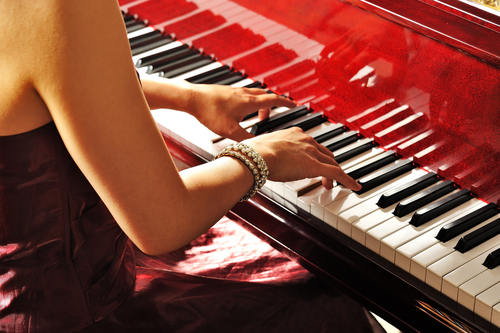 In the Middle Ages, women became important for the development of piano composition and play. But why?
In the Middle Ages, women became important for the development of piano composition and play. But why? There have long been rules and conventions regarding what women can and can’t do in the world of music at all times. Straddling the legs around a cello was considered immoral, for example, and so sitting by the piano became what ladies did. By the 19th century, almost every piano composition was written for women and girls.
“Women’s piano playing has had enormous significance for the development of piano composition,” argues Lise Karin Meling, associate professor at the Department of Music and Dance at the University of Stavanger.
But why piano? According to Meling, it agreed with the stereotype of the mild, prudent female nature. The flute, the violin, and the oboe are “highly unbecoming to the fair sex”, the music theorist John Essex wrote in 1721. The oboe was particularly masculine; it would look indecent in the mouth of a woman. And the flute would take away “many of the juices better suited to whet one’s appetite and advance digestion.”
According to Meling, the recorder was considered a highly erotic instrument, that is why there are paintings portraying nymphs luring men while playing the recorder.
“Horn and cello unsuited for the female body”
The German Carl Ludwig Junker was also plain on which instruments women were wise to stay clear of in his book on women and music from 1783: the horn, the cello, the double bass, the bassoon, and the trumpet were all highly unsuitable for the female body, female fashion, and the female character.
Playing the contrabass in a corset for instance – how ridiculous! Making large bodily movements when playing string and wing instruments – not very lady-like. A too strong and powerful sound did not agree with a woman’s modest and mild character. Drums and trumpets, Junker reminds us, are used in the military, and the horn is used for hunting, and are thus not to be considered feminine.
Besides, some playing positions were directly immoral, such as distorting ones face in order to play a wind instrument, pressing ones lips together and supporting the sound with the stomach muscles. This might give the impression of an indecent woman.
And not to mention the playing position for the cello – where a woman would have to squeeze the instrument to her chest in addition to straddling her legs. This would give people immoral ideas.
A must for bourgeoisie women
By the mid-nineteenth century, piano instruments were considered the feminine musical instrument “par excellence”; so much so that it became a norm for all women belonging to the bourgeoisie and upper classes to have a decent command of the piano.
“No cultured house should be without a pianoforte… No Lady, who wish to be a Lady, can admit to not being able to play the pianoforte, and no Gentleman can allow its disregard,” the Norwegian author Bjørnstjerne Bjørnson wrote in 1855.
Playing normally took place within the privacy of the home, in some cases when visiting others. But if you were better at playing the piano than the hostess, you had to choose a less difficult piece to avoid putting her in an awkward position. Performing in public was simply out of the question for most women. Meling refers to women’s piano playing as a “home art”. This type of musical exercise has not been considered as important as the one that took place in public.
Obviously, only using sources from the bourgeoisie and the upper classes skews the results, there is no real record of musical practice by the lower classes. A recorder is certainly much cheaper than a piano so perhaps there was more parity there. Since they didn't buy a lot of music, composers didn't write to appeal to them.
Use your hands and think of England.
In the upper classes, playing piano was a way to be more appealing in courtship. When Lady Middleton in Jane Austen’s 1811 novel "Sense and Sensibility" married, she stops playing the piano.
“She had reached what many considered the aim of music and piano playing,” says Meling. “It was a part of women’s education in order to advance their marriage prospects.”
As pianos became more popular, they became both cheaper and experimental in form and function. Due to the piano’s popularity, the relatively large instrument became increasingly cheaper to acquire. It became possible to purchase pianos that might also be used as a salon table, writing desk, cabinet, worktable, dressing table, and toolbox.
By the 19th century, piano compositions outnumbered all other instruments combined. Yet it was still feminine. The man’s job was to admire the performing woman, sometimes to turn the pages in the music book for her. He would not play piano himself, that would immediately make him feminine.
“Ethics manuals for English Gentlemen advise men against playing the piano,” says Meling.
Fear of a “piano epidemic”
At the same time, too much piano playing was warned against. The nineteenth century idea that women with a strong sex drive were prone to develop so-called hysteria was linked to music. Social authoritarians of the day believed it might overstimulate the nerve system and be destructive for women’s looks and reproductive organs. We can laugh but that is how the future is going to look back at environmental activists who worry about GMOs and CRISPR-modified foods.
The Austrian music theorist Edvard Hanslick termed the phenomenon “Piano Epidemic” – when the music gets the upper hand and results in illness.
A result of this concern was that piano tuning became a male profession. According to the theory, unmarried and thus sexually inexperienced women could become dangerously overstimulated by tuning a piano.
Citation: Meling, Lise Karin, Klaveret – et kvinneinstrument? (“The piano – a women’s instrument?”) (2015) Arr #1/2015.






Comments